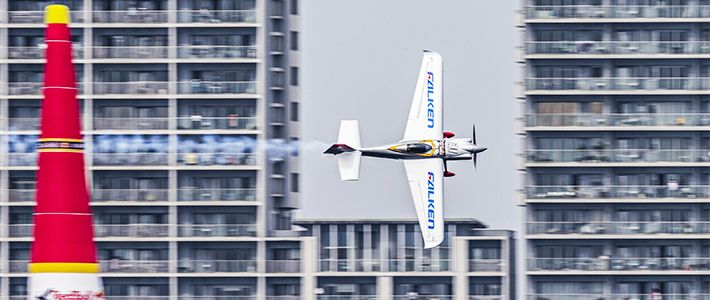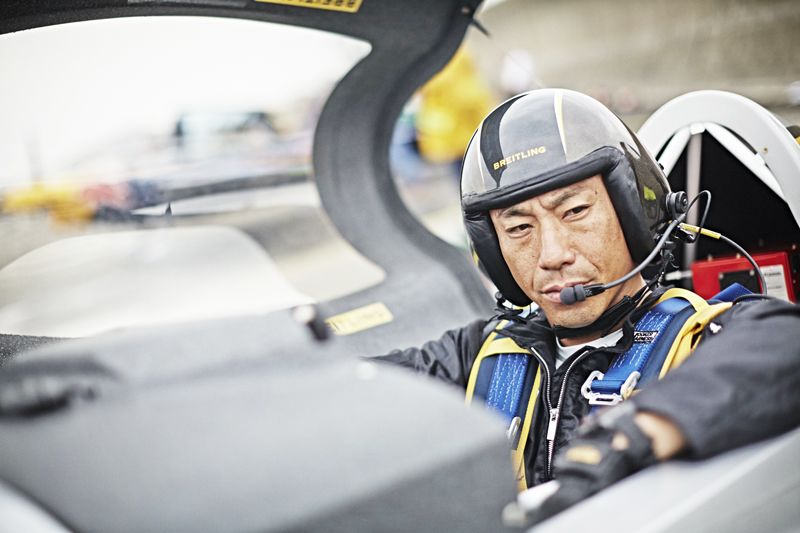
Japan’s First Air Race Draws Record Crowd of 120,000 to Chiba
Economy Society Culture Lifestyle- English
- 日本語
- 简体字
- 繁體字
- Français
- Español
- العربية
- Русский
Red Bull Air Race Arrives in Japan
“Airplanes are beautiful, cursed dreams.” So says an aircraft engineer caught up in war in The Wind Rises, the last animated film by Miyazaki Hayao of Studio Ghibli before his retirement as a feature filmmaker. The line aptly describes the ambiguous sentiment shared by many aircraft aficionados, but in mid-May that sentiment was blown away by the 350-kilometers-per-hour blasts of civilian airplanes zooming by in the first air race hosted by Japan.
The Red Bull Air Race, dubbed the “Formula 1 of the sky” and the “world’s fastest motorsport,” is a three-dimensional speed race between propeller planes. The Red Bull Air Race Chiba 2015 took place at Makuhari Seaside Park on May 16 and 17, 2015, with the participation of 14 pilots from 11 countries. Muroya Yoshihide—the first Asian pilot—performed impressively in his home country’s inaugural air race, setting a track record of 50.779 seconds in the first knock-out round. He did not make it past the next stage, however, and British pilot Paul Bonhomme went on to score his second consecutive victory in the world championship series, having also won the season’s first race in Abu Dhabi, the United Arab Emirates.
Birthplace of Japanese Civil Aviation
“Aerial Feats Enthrall 60,000” read an Asahi Shimbun headline, while the Mainichi Shimbun described the race as “really dynamic.” Meanwhile, NHK (Japan Broadcasting Corporation) wrote of the event: “Race pilots with the world’s top flying skills will compete over their mastery of piloting techniques in timed races involving speeds as fast as 370 kph and g-forces of up to 10 G.”
Officially approved by the World Air Sports Federation, the Chiba event attracted 120,000 paying spectators over the two days, the largest crowd in the race’s history. Roughly 300 members of domestic and foreign media gathered, and Japanese newspapers, magazines, television, and even information websites extensively covered the event. Excitement filled the air as fans cheered loudly for Muroya and other world-class pilots. Thanks to the event’s immense success both commercially and in terms of publicity, the race organizers have already expressed their desire to hold another race in Chiba next year, noting that the city was a perfect venue. The Japanese executive committee that hosted the event has responded positively as well and says it is “coordinating with an eye to holding [the race again next year].”
 The two-day race drew a total of 120,000 fans to Makuhari Seaside Park in Chiba. (Photo courtesy of Red Bull Japan.)
The two-day race drew a total of 120,000 fans to Makuhari Seaside Park in Chiba. (Photo courtesy of Red Bull Japan.)
The Red Bull Air Race World Championship is a series of speed races of single-engine planes held by the eponymous beverage maker in cities worldwide, including Las Vegas in the United States and Ascot in Britain. Launched in 2003 as a world series, it is in its tenth season, having had a hiatus from 2011 to 2013 for safety improvements. The pilot with the most points after the end of all races—there will be eight in the 2015 season—becomes the world champion.
The merits of holding a race in Chiba, according to the air race organizers, were that the city has historical significance as the birthplace of civil aviation in Japan, the Chiba venue lies alongside a long artificial seashore, and the city’s proximity to the capital provides an advantage in drawing spectators.
According to the Red Bull Air Race website, the series “always takes place at the most breath-taking locations on the planet,” whether over water or over land, and the pilots “often have to battle against the elements, with extreme heats, shifting winds and harsh storms always a possibility.” Chiba was no exception, and training sessions had to be called off for two days due to an approaching typhoon.
Split-Second Timing
Pilots must navigate a roughly 4-km course at top speed, maneuvering their planes through checkpoints marked by 25-meter-tall pylons at prescribed altitudes and orientations. For safety reasons, they are required to choose from among several designated race planes and comply with weight and other requirements. Competing in these planes, modified within the requirements, demands in pilots the ability to react in mere a thousandth of a second.
In the first knock-out Round of 14 Muroya beat Martin Sonka (Czech Republic), who placed sixth in the qualifying round. But in the next Round of 8 he came up against the formidable Bonhomme, the winner of the season opener. Unable to harness the power of the new Edge 540 V3 plane, which he was piloting for the first time in this race, Muroya was disqualified due to over-G. Nonetheless, his time of 50.779 seconds in the Round of 14 clipped 1.5 seconds off his qualifying round time and was the fastest in the Chiba race—faster, indeed, than the winner, Bonhomme.
 Muroya Yoshihide, the first Asian pilot in the series, competed in the first air race hosted by his home country. (Photo courtesy of Red Bull Japan.)
Muroya Yoshihide, the first Asian pilot in the series, competed in the first air race hosted by his home country. (Photo courtesy of Red Bull Japan.)
Currently in his fourth season, Muroya’s highest overall ranking thus far has been ninth place, and he has made it to the podium only once. But hopes are up for a brighter future given his performance in Chiba. (Muroya went on to mark the second-best time in the qualifying round of the Rovinj race in Croatia, the third stop in the world championship series.)
Growing Competitor Base in Asia
Most of the air race pilots are either former air force pilots or aerobatic professionals. Following in the footsteps of Muroya, Halim Othman—a former top-gun pilot of the Royal Malaysian Air Force—became the second Asian pilot in the championship race by joining the Challenger Cup. The competitor base is beginning to grow in Asia.
The first Asian location was Putrajaya, Malaysia, which hosted a race in May 2014. It was announced that a race would also be held that year in Shanghai, China, but the event was canceled shortly before the scheduled dates. In Chiba, the second Asian city to host the championship, the heated races took place against a metropolitan background of Japan’s longest artificial beach at Makuhari Seaside Park, Chiba Marine Stadium, and high-rise apartment buildings dotting the landscape around the seashore.
(Originally written in Japanese by Miki Takajirō of Nippon.com and published on June 22, 2015. Banner photo: Muroya’s single-engine plane trails smoke as it flies past apartment buildings lining the seashore. Photo courtesy of Red Bull Japan.)
tournament Red Bull air race Makuhari Muroya Yoshihide world championship